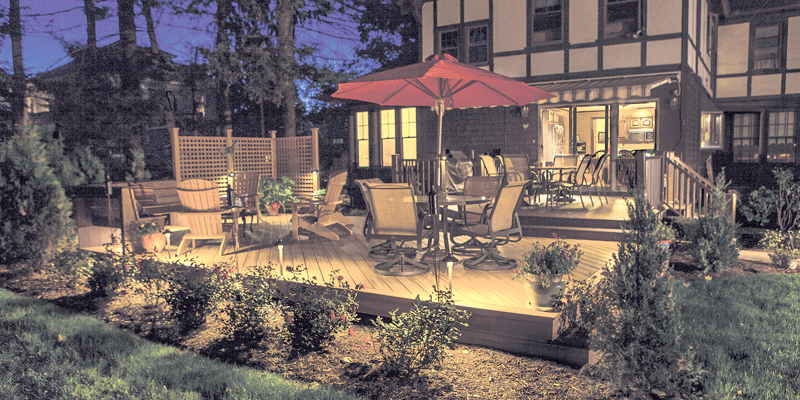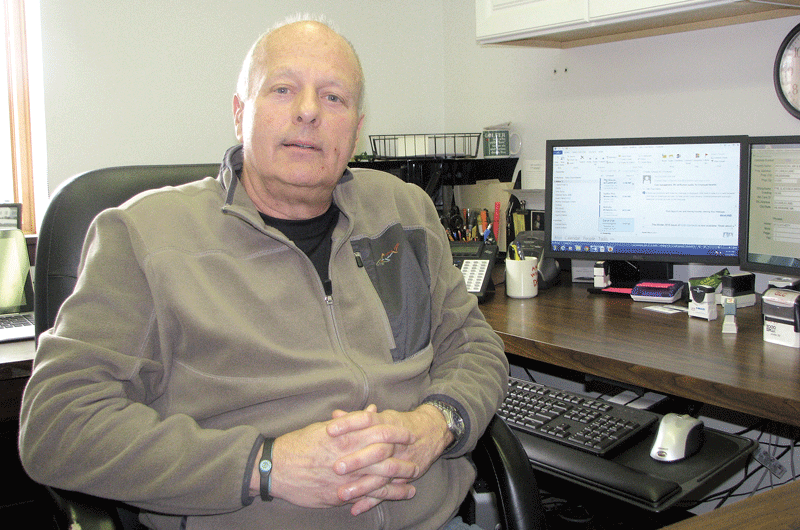Outdoor Architectural Lighting Is Both Art and Science
Painting Pictures with Light

Illumascape Lighting
When some people think of outdoor lighting, they may think of floodlights and porchlights — but many more options are available in the emerging world of architectural lighting, which accents the details of front and backyards, melding safety and security with atmosphere and aesthetics. Designing and installing these systems is both art and science, say experts in the field, who are always gratified by the ‘wow’ factor when homeowners flip the switch.
After 23 years as a graphic designer in the sign-making industry, Rob Larkham decided to design and install landscape lighting for a career — a job that requires long hours of manual outdoor labor.
“Everything we’re doing is by hand. It’s labor-intensive,” said the owner of Illumascape Lighting in South Hadley. “But at night, when we turn the switch on, it’s a rewarding moment.”
Larkham is actually the second owner of Illumascape. Phil Costello, who founded the business, was one of Larkham’s customers, and when he was nearing retirement, he approached the graphic designer, believing he would be a good choice to take over the landscape-lighting company. So Larkham came on board four years ago and took over the reins a couple years after that.
“He saw me as a hard worker with an artistic eye — because, what we do is paint pictures with light,” Larkham said of why the opportunity appealed to him. “If it weren’t for the artistic end of it, I wouldn’t have made the transition. You’re outside digging ditches all day, but then you get to the end of the day, when it’s dark, and you flip the switch and get that ‘wow’ moment.”
Landscape lighting, also known as architectural lighting, has long been popular in warmer climes, but in the Northeast, most homeowners have been satisfied with porchlights and maybe a floodlight out back. But, increasingly, they’re seeing the aesthetic value in the variety of techniques available from companies like Illumascape and numerous landscape-design firms.
As Larkham explained, landscape lighting is the permanent placement of lighting fixtures in the outdoor environment, with the aim of highlighting the form, texture and definition of landscape plantings as well as enhancing the architectural features of the home. In contrast to one or two floodlights, architectural lighting may utilize dozens of smaller, strategically placed fixtures to accent the details of a home and yard.

Rob Larkham says customers choose architectural lighting for both aesthetic and security reasons.
“It’s still really in its infancy here,” he told BusinessWest, adding that customers choose landscape lighting for two reasons: to add beauty to their property and for security. “A well-lit home is less likely to be broken into than the house next door. Plus, you’re more likely to slip on dark stairs and dark sidewalks.”
Gary Courchesne, owner of G&H Landscaping in Holyoke, said the emergence of energy-efficient LED diodes has made landscape lighting more popular, because people see the long-term value in what, admittedly, can be a hefty up-front investment.
He explained that a transformer installed in the yard converts the 120-volt household current to 12 volts, and the LED diodes reduce the energy drain even further. “From an energy standpoint, you’re getting the benefit of cost savings. That’s key for people.”
He and Larkham both noted how the fixtures are designed to direct each beam in a specific direction, with techniques ranging from uplighting and downlighting to path lighting and ground lighting.
“In other instances, we use well lights buried in the ground that give that upward lighting effect,” Courchesne explained. “You may have ornamental plants, which you want to show off and shed a little more light on.”
Added Larkham, “I just think people are seeing the value in it, whether it’s beauty, safety, security, or curb appeal. People are spending more time in their backyards. I really think the growth in this industry will be extensive.”
Professional Touch
The key to successful lighting, Courchesne said, is professional design. He noted that a flood of low-voltage lighting kits hit retail stores over the past decade, and many people bought them, were unsatisfied, and didn’t think about it again. That’s because they didn’t have a skilled designer and installer on their side.
“When people buy a big-box store kit, they’re compelled to use every light in it. But, in the instance of low-voltage lighting, less is more. You don’t want your sidewalk or shrubbery to look like a runway. You want it to highlight, accent, and provide adequate light for pedestrians and the security element.”
With homeowners in the Northeast investing more money in their properties in recent years, he went on, many are now becoming aware of professional landscape-lighting design, which is ubiquitous down South.
Larkham said customers run the gamut from contractors building a new house and including landscape lighting in the initial design to homeowners who have been in their homes 25 years or more and have an itch to do something new and dramatic with their outdoor space.
Go HERE to download a PDF chart of area landscape design firms
“Sometimes it’s a complete landscape remodel — a landscape architect may be doing the whole backyard and will call me and say, ‘hey, we’d really like to do landscape lighting in this remodel.’ That said, I’ve gone out and done simple installations of five path lights, and, on the other end, 200-light installs.”
In other words, although architectural lighting is a high-end product in the world of landscape architecture, there’s typically something for every budget. Larkham said he often works within someone’s budget for an initial installation, but might put in a larger transformer if a client expresses interest in adding to the design later. “Maybe they’ll do the front of the house this year, and the backyard next year.”
With a budget in hand, Larkham then draws on his artistic side. “That’s my job as a designer — I show up, meet with client first, figure out what they’re looking to do on their property, and come up with a design using the proper fixtures.”

This Illumascape project demonstrates how small, strategically placed lights bring out the details of a house and yard.
For example, the same kind of tree could be lit using completely different techniques, depending on the yard.
“We’ll go out and do a lighting demonstration before we ever sign a contract, with about 100 demonstration lights, to show you what the final product might look like,” he said. “We don’t have clients come out until it gets dark so we have that ‘wow’ moment. More than nine times out of 10, they come out and say, ‘wow, we had no idea.’”
In many cases, he added, a customer’s neighbors may have architectural lighting, but when someone sees it on their own property, it’s a much more impactful experience.
“You have to look at the key elements of what people are trying to accent and highlight, then decide how to use the lights,” Courchesne said. “Some people want it on the front door to highlight a wreath, using it as a spotlight. In some cases, they want to flood the area with some light. But the whole key is subdued lighting, not offensive lighting.”
He told BusinessWest that the results are gratifying.
“Some of the comments I hear are, ‘can you believe my house now?’ I hear that time and time again. I would say 75% of the folks who buy landscape lighting, accent lighting, buy it for the aesthetic value. The other 25% also want it for the security value because lights deter a burglar; they’d rather go to a house that’s dark as opposed to a house that’s lit up.”
Left to Their Own Devices
As landscape lighting becomes more prominent in the Northeast, customers are accessing some high-tech features not previously available. Residential Lighting magazine noted that, while low-voltage LED lighting is the key industry driver these days, linking lighting systems to smartphone apps, to control them remotely, is also a hot trend.
Other systems are timed to come on automatically, Larkham said, so that, “in the winter months, when it’s dark when you pull into the driveway, the house is warm and inviting already. That’s nice. Floodlights tend to be Fenway Park bright; obviously, what we’re doing is soft and subtle. That’s really what we’re looking for.”

Gary Courchesne says the goal of any landscape-lighting project is subdued, artistic light.
Courchesne also stressed the importance of subtlety in a lighting plan. He said today’s LEDs can bathe their target with a soft, warm, white glow, as opposed to the harsh blue light with which some people associate earlier LEDs.
“Not everyone can afford this,” he stressed. “It’s cost-effective from an operational perspective, but there’s capital investment involved for a quality system. Like anything else, you truly get what you pay for.”
Larkham added that, as time goes on and LEDs become more universal, costs should come down, and are already starting to creep in that direction, which is a good sign for homeowners who want to add a little artistry to their landscapes.
“It’s becoming more popular, it seems the technology is advancing every year, there are always new things happening,” he concluded.
In other words, the future is bright.
Joseph Bednar can be reached at [email protected]





